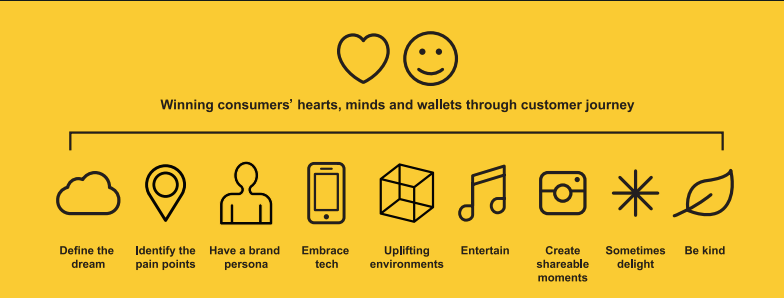Building Customer Journeys, and Winning the Battle for Consumers’ ‘Hearts, Minds and Wallets’
Like so many facets of branding today, customer journey has become increasingly linked to emotional triggers. Unless brands are able to emotionally seduce customers, then brand owners should not be surprised if their brand loyalty is tested. This battle happens every day, whether it be on the high street, in the shopping isle, on screen or online. It is imperative that brand owners recognise the three main ways in which they can build a strong emotional connection between consumers and the brands which are created for them. First identify points of friction along the customer journey, next always be mindful to keep the customer front of mind, or in other words ‘try walking a mile in their shoes, and thirdly, understanding the moments of sheer magic that will keep them coming back for more.

One way of thinking about making a customer journey sincere is to take an approach that enables the brand to ground each behaviour in fact or a core truth. This means that each action is driven by a brilliant piece of insight. This is not easy as almost all brands have multiple stakeholders that have a very different set of needs and wants. These are not only different, but in many case they are quite individual and particular. Some need a step-by-step and ushered experience, while others want to be made to feel special or expect a sense of occasion. To do this, brands must take consumers on journeys which strike an emotional chord with them, and one which will resonate with their needs.
This underpins why a well-orchestrated customer journey is so important. It offers a complete overview of the experiences that customers go through when engaging with any given service, product or interaction. Simply by trying to meet consumers mid-way, a brand can open a dialogue. An example of this could be made by embedding an opportunity to introduce a distinctive tone of voice that begins to separate the brand from all other competitors. This can easily manifest itself in the way the brand asks a question, makes a suggestion, or carries out a demand. With this behaviour comes the formulation and evidence of a brand persona… friendly, professional, authoritative or caring.
Identifying where the friction lies
This requires an honest appraisal of the entire road map. Starting with an in-depth brand audit, the analysis and key insights that are gathered will not only identify the touch points that are lacking emotional engagement but will also map the ways in which the experience can be addressed and improved. By making an emotional map of where the brand can react to customer needs, brands will be much better equipped to pre-empt the ways in which a meaningful difference can be made. Think of how it feels when you are stuck in a slow-moving queue feeling as though is life passing you by, then imagine that negative experience being punctuated by and entertaining moment that alleviates the boredom, even if just for a short while. It will have caused a welcome distraction and given the consumer a story to tell, and something positive associate the brand with.

Keeping the customer front of mind
In this mode the brand is looking at specific parts of any transaction to track the pinch-points and highlight where experiences are not fluid enough, and where there is an opportunity to create some positive play back. Being customer-centric and using strategic tools to plot the customer journey will help to get closer to the customer and understand the priorities and how best to design the experience for them. This allows the conversation to turn from brand milestones to brand expressions. The brand investment made here is absolutely key. And the discoveries made will be like having a moment of realisation when brand owners can be made to understand that if one thing can be mastered, then it just might be powerful enough to soothe an entire journey. For instance, this could be like the ease of digital accessibility throughout an airport journey. It is also worth pointing out that some consumers do not experience a linear journey, as they hop between multiple states and sometimes experience several of them at the same time.

Moments of sheer magic that keep them coming back for more
Make no mistake, the ultimate motivation for a brand’s customer journey is to convert a trial customer into a repeat ‘visitor’ and eventually a brand advocate. The best brands do this time and time again, and we know when they have reached this status when people invariable cannot do without them – think of your number one go-to online digital brand that you use regularly. The reasons that you are compelled to re-use it is because it is super quick and easy to manage, it knows (or more importantly remembers) who you are and makes you feel welcome every time, suggests without being pushy, and signs off in a memorable way. The icing on the cake is when it somehow makes you feel special every single time you return to engage with it. Customer journeys that achieve those all-important connections that are built on emotional attractions are invariable associated with brands which people trust.

In conclusion, by mapping the opportunities for emotional interaction between the brand persona and the audience, companies and organisations can ensure an engaging customer journey experience. This also means that they must do what it takes to win the hearts and minds by making the brand the star within an intriguing storyline. This allows the consumer to align themselves with the values of the brand and link their personal ambition to the goals of the brand. This supports the fact that business success is almost always synonymous with high customer engagement.





